ABOUT ROSS LOVEGROVE
Born 1958, Ross Lovegrove
graduated from Manchester Polytechnic with 1st Class BA Hons Industrial design
in 1980 and took a Master of Design at the Royal College of Art, London in
1983. In the early 80’s worked as a designer for Frog Design in West Germany on
tech projects for companies like Sony and Apple; he later moved to Paris as a
consultant to Knoll International, for which he created the highly successful
Alessandri Office System.
Invited to join the
Atelier de Nimes in 1984, alongside with Jean Nouvel and Philippe Starck, he
consulted amongst others: Cacharel, Louis Vuitton, Hermes and Dupont. Returning
to London in 1986 he has since worked on projects for Airbus Industries,
Kartell, Ceccotti, Cappellini, Moroso, Luceplen, Driade, Peugeot, Apple, Issey
Miyake, Vitra, Motorola, Biomega, LVMH, Narciso Rodriguez, Yamagiwa, Tag Heuer,
Swarovski, Herman Miller, Artemide, Renault, Japan Airlines, Toyo Ito
Architects, kenzo, Valextra, Gh Mumm, LG, F1, Samsung and KEF.
Winner of numerous
international awards his work has been extensively published and exhibited
internationally including the Museum of Modern Art in New York, the Guggenheim
Museum NY, Axis Centre Japan, Pompidou Centre, Paris and the Design Museum,
London, when in 1993 he curated the first permanent Design collecton. His work
is held in permanent collections of various design museums around the world
including the Museum of Modern Art in New York (MOMA), the Design Museum ,n
London, the Vitra Design Museum, in Basel, the Die Neue Sammlung, in Munich and
the Centre Pompidou, in Paris.
https://www.rosslovegrove.com/story
All the knowledge, questions and Ross Lovegrove answers came from Ross Lovegrove’s web page.
CULTURAL RECOGNITION
The Centre Pompidou
recognised that Ross Lovegrove’s unique vision of Design was representative of
how the transition from the 20th to 21st Century would play out. In 2016 it
hosted a 1000 square-meters exhibition of his work entitled ‘Convergence’. How
science, technology, art, anthropology and ecology can converge to drive a new
but intelligent approach in design with truly new aesthetics and physiognomy.
Ross Lovegrove describes himself as an ‘evolutionary biologist’ but also a
visionary and a sculptor of technology, defining a new genesis of how we can
harness the incredible potential of planetary resources to create economic, fat
free, lean and efficient products. He was the first designer to present at TED
Global alongside James Watson co-discover of DNA, Craig Ventor, who mapped the
human Genome and, Janine Benyus, the author of Biomimicry. His second TED talk
called Genesys, presented at Oxford university further reinforced his view that
industry needs to transition from the fossil fuelled and mechanical to the
natural and biological by instinctively designing with a very present
synergistic mindset using advanced digital design and progressive manufacturing
methods.
https://www.rosslovegrove.com/story
AWARDS
• RED DOT DESIGN AWARD
2022
• ARCHITECTURE MASTERPRIZE WINNER 2022
• MARK WILKINSON AWARD FOR LIFETIME ACHIEVEMENT 2021
• GRAND PRIX DU DESIGN GOLD WINNER 2021
• GERMAN DESIGN AWARD 2021
• DEZEEN AWARDS FINALIST 2020
• GOOD DESIGN 2020
• GERMAN INNOVATION AWARD 2020
• RED DOT DESIGN AWARD 2019
• ELLE DECO EU 2019
• ELLE DECO CHINA 2019
• LIT DESIGN AWARDS 2019, LIGHTING PRODUCT DESIGN OF THE YEAR
• GOOD DESIGN 2019
• GERMAN INNOVATION AWARD 2019
• GERMAN DESIGN AWARD 2019
• ARCHITECTURE MASTERPRIZE AWARD
• EUROPEAN PRODUCT DESIGN AWARD 2019
• ICONIC AWARDS 2019
• IF DESIGN AWARD 2019
• IDA DESIGN AWARDS, GOLD WINNER 2019
• DESIGNBOOM LIFETIME ACHIEVEMENT AWARD 2018
• GERMAN DESIGN AWARD 2016
• RED DOT 2015 BEST OF THE BEST
• ALSACE INNOVATION AWARD 2015
• GERMAN DESIGN AWARD 2015
• LIT DESIGN AWARDS 2011
• REDDOT 2010 BEST OF THE BEST
• HUNGARIAN DESIGN PRIZE 2009
• BATIMAT DESIGN AWARD 2009
• VOGUE TRAVELLER ECOLOGY PRIZE, SOLAR TREE MAK VIENNA, 2007
• ELLE DECOR 2006
• GOOD DESIGN 2006
• WALL PAPER DESIGN AWARD 2006
• WORLD TECHNOLOGY PRIZE, TIME MAGAZINE/CNN 2005
• FINAL NOMINATION FOR THE PRINCE PHILLIP DESIGN PRIZE 2004
• GOOD DESIGN 2004
• JANUS PARIS 2004
• AWARDED ROYAL DESIGNER FOR INDUSTRY BY THE ROYAL SOCIETY OF ARTS 2004
• ‘DESIGNER OF THE YEAR’, A & W HAMBURG 2001
• ID MAGAZINE GOOD DESIGN AWARD 2000
• IF INDUSTRIE FORUM DESIGN AWARD, HANNOVER 1999
• MEDAILLE DE LA VILLE DE PARIS 1998
• GEORGE NELSON AWARD 1998
• D&AD SILVER MEDALIST
BD LOVE LAMP
YOU WERE A PIONEER IN THE
USE OF 3-D PRINTING IN YOUR DESIGN WORK. HAS THAT PROVEN REVOLUTIONARY?
I’d say technology [such as]
3-D printing has had an effect that’s both good and bad. I’ve always tried to
adapt – Darwin never spoke about the ‘survival of the fittest’ but the
‘survival by adaptation’ and I remembered that, so any time some new tech comes
along that will change the polarity of how we create, I jump on it. I did the
world’s first magnesium-injected chair years ago and I made a model of [it] in
my workshop, spraying foam, covered in dust, breathing it all in... And that
was the last time I ever did anything in a workshop. After that, I hired the
right people, bought these new computers, bought the software and, rain or
shine, decided that approach was what I was going to do.
Ross Lovegrove
THE TOOLS AND PROCESS YOU
OFTEN USE ARE ESSENTIALLY CUTTING-EDGE. HOW DO YOU MONITOR THE SPEED OF
TECHNOLOGICAL CHANGE?
We work with a network of
the most advanced people across Europe and beyond, and my team are high-level
generative designers, mainly architects who understand modern processes. The
creatives I work with are among the best in the field of parametric modelling
and 3D printing. We are like a digital SAS unit. At our level, the process of
computational work is very intense, but the positive side that you get to
create things that are very enriched, formally really beautiful and ever so
complex in a sculptural sense. You see this kind of extreme digital design
mainly in
architecture, like with Zaha Hadid studio, or 2D AI-generated imagery, very
rarely in physical industrial design like I do.
Ross
Lovegrove
BD LOVE BENCH
KEF
MUON
Sculptural loudspeaker
for KEF, 2007. The aim with the creation of Muon was to marry a sensual yet
logical organic form to state-of-the-art audio technology. Ross Lovegrove is a
visionary, materials-led, industrial designer. His career has been galvanised
by the form-inspiring and poetic qualities of materials and manufacturing
processes – what is unique about his work, is his holistic approach to design –
his aim is always to create objects in which functional and ergonomic
refinement are united with deep emotional magnetism.The result of this
collaboration with KEF is a speaker which holds a seductive, curvaceous form,
inspired by the abstract sculptures of Barbara Hepworth and Henry Moore, yet
boasting a technology- driven acoustic design that has managed to establish a
major benchmark in clarity. As KEF’s senior Acoustic Engineer, Andrew Watson
states ‘we wanted to take our technology to the limit and then develop some
more on the way.’ The upshot is an unparalleled loudspeaker that will bring to
serious audiophiles as well as music lover’s sound quality that defies belief -
a product that is spectacular and which is able to imbue the perfect synthesis
of art and science.
VİTRA İSTANBUL SERIES
DOES BEING THE ‘ORGANIC DESIGN GUY’ FEEL RESTRICTIVE TO YOU SOMETIMES?
Well, I’ll never forget dealing with VitrA – the bathroom company in Istanbul, not the other Vitra, (by the way it took about 45 minutes after they called to work that out) – and [spending] an hour talking [to them] about sculpture….We spoke about Henry Moore, paganism – all that – and it was that connection that made me take on their project. Anyway, at the end of the day, they said they wanted a ‘Ross Lovegrove’ bathroom. I said, “Please tell me, what’s a Ross Lovegrove bathroom?!” And they said “It’s white and organic” – which, as it turned out, was actually right for the product. Still, slowly over the years I’ve been trying to twist that white, curly and futuristic label to get a bit more free from what people expect you to deliver as a designer. Organic design is just one of the definitions describing what I’m trying to do with creativity and expression.
Ross Lovegrove
VİTRA İSTANBUL SERIES
SPINE CHAIR
GINGKO CARBON
TABLE 4
HOW IMPORTANT IS THE
SCULPTURAL ELEMENT IN DESIGN TO YOU?
I believe I am a
sculptor; designer is just a title. I’m more interested in the emotional
presence of the object. Mine is a form of generative design, meaning they grow.
If you think of old mechanical objects, they were bulky and oily and squeaky.
But we’re in a new age now – with digital design, you press a button and this
object grows out of nowhere. It is incredibly emotional. So, why would anyone
do things the way they were done a hundred years ago? Some of my designs may
seem insignificant, but at least they test an ideology.
Ross
Lovegrove
YOU TALK OF CREATING A
NEW AESTHETIC FOR THIS CENTURY THROUGH THE CONVERGENCE OF TECHNOLOGY, MATERIALS
SCIENCE AND INTELLIGENT ORGANIC FORMS. HOW DO YOU SEE THIS SHAPING?
I’ve been designing since
I was 16, and there hasn’t been a day when I haven’t considered how things are
made. Design has therefore become instinctive. You can get through this
business being distant, copy and be lazy. But I won’t make anything that could
be made even five years ago. I want people to be able to carbon date my
designs, to remain relevant, not only in terms of process and materials but
also the changes in our environment, social and cultural. What we do here is an
aesthetic revolution - sculptural and technological.
Ross
Lovegrove
ARTEMIDE
SOLAR PANEL
DESCRIBE YOUR STYLE AS A
GOOD FRIEND OF YOURS MIGHT DESCRIBE IT
I’m an evolutionist, more
than a designer. I don’t know what design is anymore, I create form, I
understand form and I’m enjoying the digital age to create it. I’m hoping to
push that even further. My work also relates to nature, in an evolutionary
sense as I’m concerned with reduction. I exercise what is called ‘organic
essentialism’ which means using nothing more – nothing less than is needed. I
feel comfortable in this organic, isomorphic, anthropomorphic, liquid age of
making things, but I try not to force it into things that don’t need it.
Ross
Lovegrove
WHICH OF YOUR PROJECTS
HAS GIVEN YOU THE MOST SATISFACTION?
Personal projects because
I do them for myself. I loved working on my design-art seminal works. A series
of pieces that I have made in carbon fibre and aluminium. Those really
synthesise the concept of ‘organic essentialism’. Art kind of works and
exhibitions are always a moment of hesitation for me, I’m looking internally at
what I do so that I can grow again. Then there are also the products that I’m
known for, like the water bottle for instance, that have sold very well, but
these projects for me are really more about the meaning of ‘why we produce
them’. I’m always trying to do things with minimum resources but at the same
time achieve the maximum iconic effects. Ultimately I’m looking for a ‘system’
that can let me approach the work that I do with some degree of logic and
intelligence.
Ross
Lovegrove
MUMM
PACKAGING
X APPLE
VISION PRO
SERRALUNGA
NEW WAVE
CAN YOU DESCRIBE AN
EVOLUTION IN YOUR WORK?
One grows up, and has a
series of influences and those influences bear down on how you design objects
eventually in your life. Some of my early work was definitely experimental. I
was exploring and trying to see where I would fit in. A defining moment was a
camera that I did at the Royal College Of Art during my studies. At the time
the Memphis movement was all the rage, but I doubted that whole language to be
honest, the colours and basic geometries didn’t feel very natural to me. So I
designed this camera, that to me defined some sort of restraint, which I still
have in me. Very much like my DNA staircase, a self made object, which has
everything that I’m looking for – in terms of elegance of form, minimum
material, appropriate technology and succinct function. If I were to do a
camera now though, I have this feeling that I should do it in a cartilage type
of material, somewhere between nylon and silicon, or biological skin. I’m often
looking at principles called netification, choralization and reduction of mass
through perforation and so on, not necessarily in terms of products but cars
and architectural projects too.
Ross
Lovegrove
BERNHARDT GO
Go chair for Bernhardt Design. 1998-2001. This chair, manufactured from pressure die-cast magnesium, is the first of its kind in terms of its use of such technology, materials and fluid organic language in the field of furniture design. Seen as defining a new aesthetic for the 21st Century, born out of an anatomical approach to form and produced in light of the advanced principles of automotive precision manufacturing, the Go Chair was selected by TIME Magazine as one of the finest examples of design in the year 2001. As seen in Tadao Ando’s Fort Worth Museum of Contemporary Art in Texas, and Elon Musk’s Space X factory in LA, it is actively collected by various museums around the world and used in contemporary sci-fi movies.
APPLE AMONITE
AN LEPH
SWIVEL CHAIR, DRIADE
DRIADE GEO
DISC CAMERA
The Disc Camera first
developed by Kodak in the US was an attempt to create a new photographic
formatting system. It was an array of negatives 11x9 mm that would rotate into
alignment with the lens. The design for its body did change in accordance with
this new geometry but the result I thought was quite banal and cheap and below
the potential of the technology. I took on this project as my Master Degree at
the RCA in order to rethink product design and establish a discipline in my
thinking. The Disc Camera was built like a coke can with thin aluminium shells,
reduced to its minimum I mounted the film cassette externally to slim the form
and sculpt it to be as slimline as possible not dissimilar to the lines of a
later Macbook Air, a method of visually and morphologically thinning
technology.
KEF MU7
EARBUDS
WHAT ARE YOU DOING NOW?
I thought that by now I
would have completed a project for an electric autonomous car and a new
small-scale architecture that would both relate to contemporary issues and
material/technological capabilities. I was getting really close up until about
two and a half years ago and then covid and the Europe-Russia political crisis
hit and kind of took away these possibilities. I had spent a lot of time and
energy trying to set these up, so I became rather demoralised and it took the
wind out of my sails for a little bit. Now I'm trying to reinstate those
ambitious projects again but in the mean time I keep myself busy working on
speculative and personal art pieces with as much invention and optimism as I
can.
Ross
Lovegrove
LIQUID
BIOFORM
LANDSCAPE
WHERE WOULD YOU LIKE TO
BE IN A FIVE-YEARS’ TIME?
In five years I would
hope to have had some exhibitions of my work that give me the opportunity to
organise my mind and understand better what my contribution was, is or could be
in the creative world. I will probably look for projects that complete my body
of work as a designer, or revisit some projects that I always thought could be
better. As a sculptor/artist I will continue to express my inner most feelings
which indirectly reinforce my design and explore concepts that move people
emotionally from the deep past to the deep future. I will continue to seek out
my dream of transportation and architecture even at a modest scale but if this
does not happen by commission I will probably try to build those myself. I will
always continue to draw and try to stay relevant.
Ross
Lovegrove
VONDOM
BIOPHILIA
YOU CALL YOURSELF A
SCULPTURE OF TECHNOLOGY, ARE YOU A DESIGNER OR A SCULPTOR?
As a Designer I consider
myself a sculptor of materials and technology; and as a Sculptor I am aware of
the transformational power of form whether it reveals functional intelligence
or expressive abstraction.
WHAT ARE THE DIFFERENCES
OR SIMILARITIES BETWEEN DESIGN AND SCULPTURE?
Sculpture within design
brings iconography and strength of concept whereas Design within Art becomes a
popularising weakness in my opinion.
Ross
Lovegrove
MOROSO
MONOLITH
Roto-moulded chair for
Moroso, 2016. Monolith takes a cubic block and sucks in the form to establish a
visual dialogue between the organic and the linear. Organically Essential it is
where human anatomy informs physical mass ….. There is a powerful geometric
emotion in its presence, its inviting for a human to sit but also space
defining so that alone it speaks as a sculpture either in an organised or
random way in space.
CAN INDUSTRIALISED AND
MASS-PRODUCED OBJECTS BE REGARDED AS ART?
If you look at them as
facsimiles, and referenced for printed art editions, then yes. Higher numbers
tend to reduce the value but equally make the initial art accessible to a
greater audience. For example the TyNant PET water bottle I designed in 2001
has sold multiple millions of examples. As an icon of water itself it was
conceived by drawing on an early digital Wacom tablet then carved by hand in
the analogue sense. For me the initial intense months of search for its unique,
immaculate form was never lost in the massreplicated industrialised product and
remains as a seminal embodiment of Art in Design.
Ross
Lovegrove
WHAT MOTIVATES YOU MORE:
CREATING SCULPTURE OR CREATING DESIGN?
Design is a process of
calculation and problem solving where reasoning leads to success. It's where
you have a clear vision and then have to convince many others to approve or
believe in your aesthetics and objectives. I’ve always had a problem
reconciling my concerns about the
motivation of design as a service linked to consumerism in the negative sense.
I am personally motivated by ultimately achieving with clarity my first
conceptual vision without compromise no matter what I’m working on. I am
searching for something with sensual, emotional and physical qualities that are
previously unseen or untouched. Design and the industrialisation of it, is a
powerful contemporary indicator of our modernity and command of our resources.
So I’m seeking to create, fresh, new-born and inspiring physicality in my
designs that are not superficial, that’s why I look to sculpture for some form
of endurance over technological obsolescence. But in being true to self I am
spiritually moved by sculpture that seems to have emerged from the Earth or the
human imagination and that retains a living power of its own. There is force
and energy in form and material fusion that pulls on you and I want to
understand with my work if there are new original aesthetics emerging that can
augment this evolving phenomenon.
Ross
Lovegrove
ZANOTTA
BRASILIA
CRYSTAL
AEROSPACE
Crystal Aerospace
conceptual advanced automative concept for SWAROSVKI Optical Laboratories.
2006. Since I can first remember the shape of the cars developed from the
trans-Australia Solar Car Race have fascinated me.
This a world
where nature and technology fuse with mans ambition to achieve ultimate
performance levels and create a true sense of a sustainable future for us .
The forms
that have evolved from this particular science embody logic and beauty and
stimulate visionary dreams of lighter structures, advanced materials
innovation, ecologically harmonised transportation systems and a life of
silence and clean air.
Such scientifically engineered entities are art forms of the
highest order, and now that we have entered the 3rd Millennium with all our
collective hopes and fears, they for me symbolise the potential of man’s
creative thinking and help us refocus our collective ambition.
Instinctively
I present this as a concept which converges the intelligence of solar
innovation with the optical, scientific arm of Swarovski in order to
investigate the potential of using crystal to amplify light.
Polycrystalline
Photovoltaic cells embody the word ‘crystal’ in their original definition so
the legitimacy of their correspondence in this project to evaluate discovery
and performance is the key to my work in this field.
LUCEPLAN
SOLAR BUD
ESTABLISHED & SONS MOOT
MOOT or Mood Of Our Time
is a carbon fibre chair that continues the ongoing interest that I have in
elevating the perceived value of this incredible material. The chair remains a
good host for exploring the relationship between materials, technology and
structure. Moot explores the skin dynamics of a single surface that absolutely
adheres to and respects the contours of human anatomy and the concept of
‘exoskeleton’ in structural support. Between Art and Design it is limited in
its production edition by virtue of its requirement of advanced skills in
carbon layup and craft which are rare.
ARTEMIDE SKYDRO
WHAT ARE YOUR THOUGHTS
ABOUT AI SOFTWARES AND THEIR INTERVENTION IN THE CREATIVE WORLD?
The emergence of AI
softwares to imagine and visualise is an inevitability given the human desire
to bring the hyper-realism of advanced CGI and animation - that we have seen in
movies for the last couple of decades - into the fields of three dimensional
creation. Parametricism, scripting and the use of subdivision and morphogenesis
has led to exciting new structural aesthetics that are helping us transition towards
a more biological expression and 3D physiognomy in our physical environment.
The potential link to additive manufacturing is profound at all scales and
physical states... what is unfolding is an unstoppable new force of nature that
acts in symbiosis to challenge all previous methodology and results in terms of
the otherworldliness that is emerging in human visual expression.
Ross
Lovegrove
HOW DO YOU WORK WITH
MIDJOURNEY AND DALL-E?
Well first their titles
do describe this as a journey of discovery and surrealist dreams
suggesting that AI is releasing a form of sub-consciousness that consciousness
in the human imagination is too self-conscious of exploring. For
years I have been experimenting with the concept of complexity, form, structure
and material appropriation moving from the Analogue process of the 20th Century
into the Digital realm of the 21st Century using every
new tool that’s come available at its inception. What creatives can see in my
work now with this new software is a dialogue between my life’s work and
an artificial intelligence that is fully informed by imagery and discourse,
so that outputs are initiated by acceptance and freedom of co-expression,
then revised over and over until the design becomes closer to my
vision. The results often challenge my philosophical position about
purpose, scale, extreme expression, fabrication and even what my design
represents but I accept that these concerns will meld into the process
once the ability to talk and express feelings together will resonate in a
highly sophisticated mutually future orientated ambition. One way to start
this process is to see this software as partner in redefining one’s
creative language and thus guiding and influencing a new evolutionary
curve. In both of my TED talks I have eluded to this synergy founded upon
our increasing understanding of the building blocks of life…at TED Global
in Oxford in my talk entitled ‘GENESIS’ I was articulating the need to
use algorithms to replace human design process in order to form a closer
bond to the logic and beauty of our biosphere and Nature’s embedded
intelligence. I believe that with the correct inputs, agency and awareness of
all things considered, AI will be capable of defining the absolute
logical basis of why, how and what we create…so that DESIGN becomes a new
force and regenerative tool for life addressing all the issues that
confront us.
Ross
Lovegrove
HOW DO YOU SEE THE FUTURE
OF THE DESIGN AND ART PROFESSION?
Once we understand how to
create the manufacturing data set from this AI softwares visualisation
and produce almost at a cellular biological level, then the forms and
structures we see will drive a radical and disruptive-paradigm-shift in
the physicality and perceived value of everything including
Art. When I see works by artists like Refik Anadol’s ‘Quantum Memories’,
the emotional charge is like nothing else we’ve ever experienced. It is
truly mind-blowing as well as mind-expanding as an alternate dimension of
the natural World and a radical visualisation of our digitised memories
of Nature. The future will hopefully pull together the best of VR, AR, QP,
AI, EI, The Metaverse , NFTs and more, to makes us realise that what we
create and make in the real dimension of our existence needs to be
ultimately more inspiring, experiential, meaningful and emotional.
Ross
Lovegrove
MOROSO
SUPERNATURAL
MOROSO
SUPERNATURAL
WHEN YOU WERE A CHILD,
DID YOU WANT TO BECOME A DESIGNER?
No, it was rather
incidental. I don’t come from a family that has any relationship with design. I
grew up in wales in a military family, so there’s a sense of strategy in me
which helps me organize. I didn’t know that I would be a designer, though I’ve
always been interested in form since I was a young child.
Ross
Lovegrove
WHO WOULD YOU LIKE TO
DESIGN SOMETHING FOR?
I would have loved to
design for David Bowie, I’d like to work with a great musician. somebody that I
could design a great bespoke musical instrument for that would perhaps allow
them to experiment.
Ross
Lovegrove
IS THERE ANYTHING THAT
YOU ARE AFRAID OF REGARDING THE FUTURE?
It is a bit like boiling
the frog at the moment, something is certainly bubbling on the surface. I doubt
we really get the big picture. We live in these big cites or comfortable places
where food is delivered to our door and everything else is there for us. I
don’t think that we fully understand the implications of climate change,
political instability, population growth and resource draw-downs. There are
some really big things happening in the world that will start to eclipse the
superficial debate about aesthetics within the creative fields. There is an
amazing potential for the industries and brands to engage in something that is
way much more meaningful, global and human in the bigger debate. In my opinion
there is more opportunity and business to be made joining the front-line of the
revolution rather than going against the grain of basic human needs.
Ross
Lovegrove
DANESE 100%
FRIGHETTO
OASI
YAMAGIWA ANDROMEDA LIGHT
SALVIATI
DNA 01
High-perfomarce composite
staircase, 2003. The DNA Staircase bridges product design and architecture,
demonstrating its designer’s philosophy towards the coalition of beauty and
logic, as inspired by natural forms. Made using the process of bladder moulding
– a contemporary technology developed in the field of high-performance,
composite material component manufacture – DNA is the first project to be both
designed and produced by Ross Lovegrove. It is made from a combination of
fibreglass and unidirectional carbon, endowing the piece with enormous
structural integrity and resilience. It achieves much through its minimalism
with form, material and technology working in unison, not unlike the structure
of bone, it is informed with evolutionary purpose by Lovegrove’s origination of
Organic Essentialism.
MOROSO DIATOM
MOROSO DIATOM
100% aluminium vertical
stacking chair for Moroso.DIATOM as the word implies is a design which has been
generated by the beauty and logic of natural lightweight structures familiar to
architects and marine biologists who study intelligent growth logic. The chair
has undergone a series of developmental iterations to arrive at a design that
responds to the logistics of contemporary aluminum pressing technology and its
origins in the automotive industry. It is entirely computer generated resulting
in a universal geometry that is ergonomically neutral, lightweight and
providing a vertical stack that is rarely achieved. My path in the designing of
chairs is to embrace technologies that open up new possibilities and with this
a commitment to explore the moment where industrial investment can result in
products which are aesthetically uplifting, long lasting and respectful of
environmental issues yet economically accessible from a cultured design house
to a wider audience.
WHAT IS THE BEST MOMENT
OF THE DAY?
I think about four ‘o’
clock in the afternoon as I tend to slow down a little and contemplate what has
happened, what I have done so far and what I still have to do that day. It’s a
very critical and anxious moment in my day, it’s either love or hate.
Ross
Lovegrove
MALETTI WET
WHAT BOOKS DO YOU HAVE ON
YOUR BEDSIDE TABLE?
I don’t have a bedside
table, rather a huge pile of books that are next to my bed, mainly on art and
architecture: Tony Cragg, Anish Kapoor, Isamu Noguchi and many exhibition
catalogues.
Ross
Lovegrove
BERNHARDT ONE
BERNHARDT
ORBIT
VOID ILLUSION





.jpg)















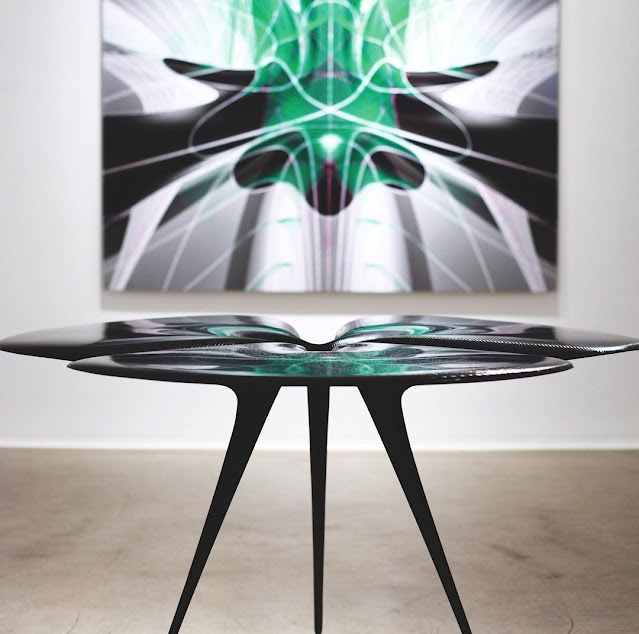











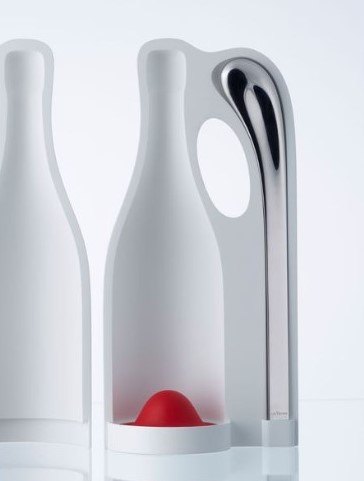











































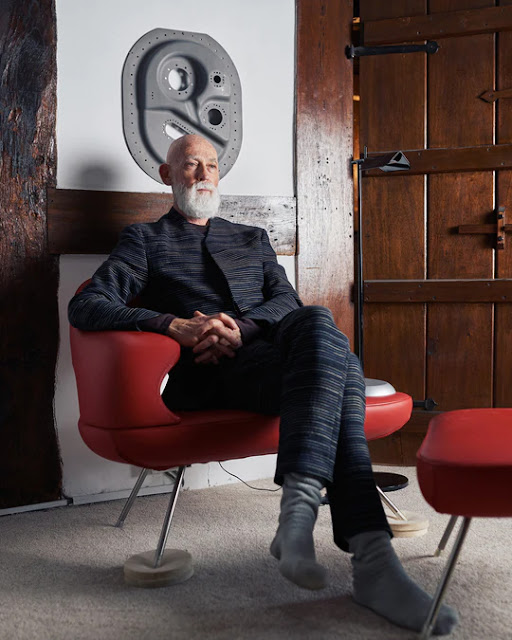
















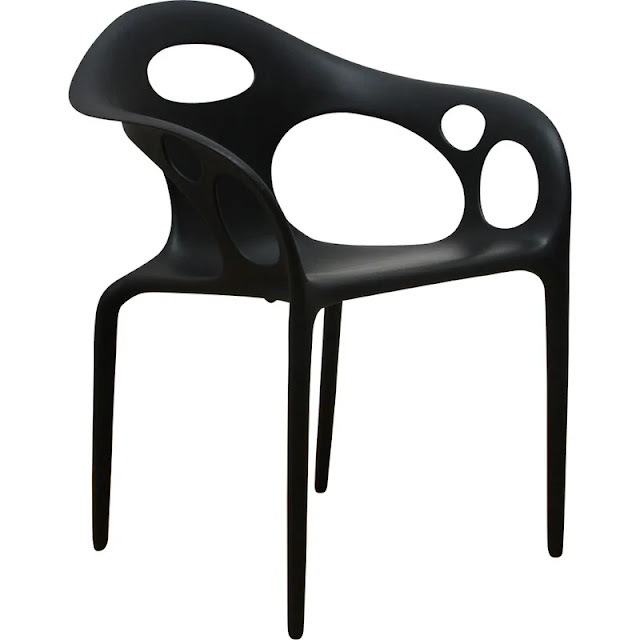





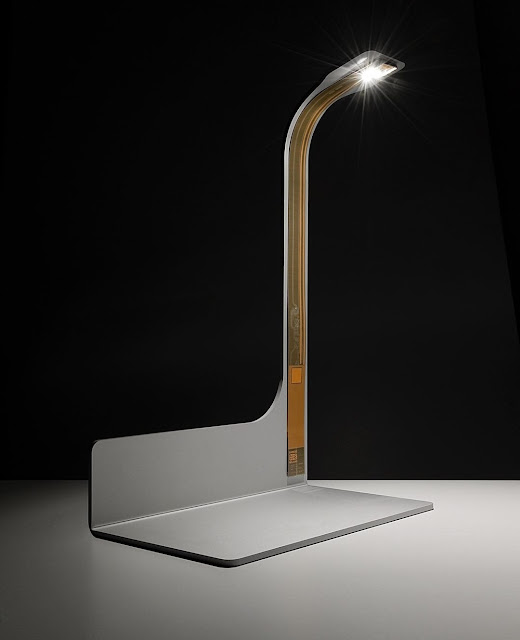










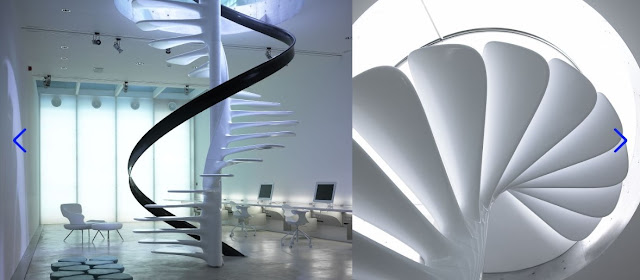























.png)